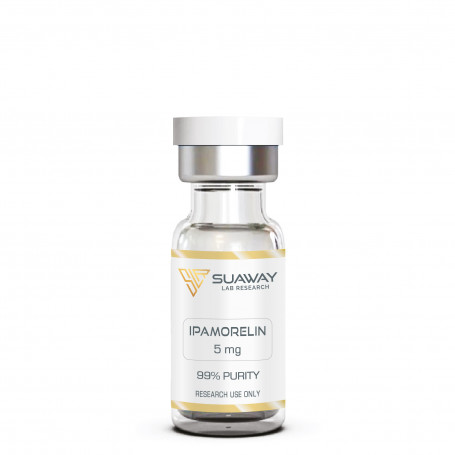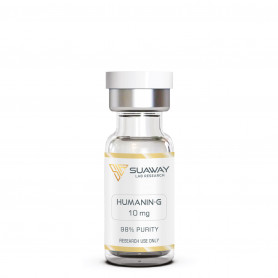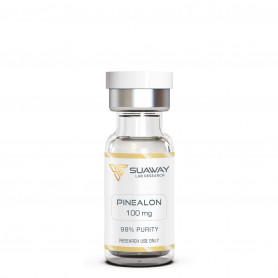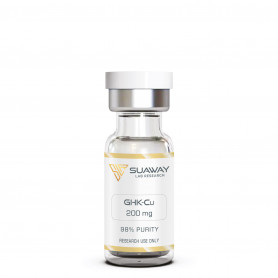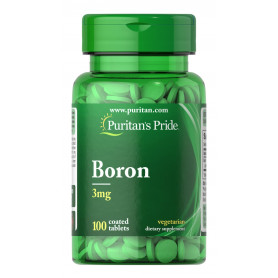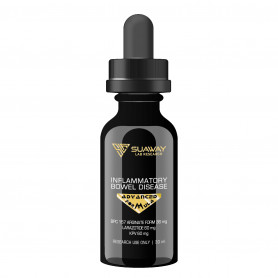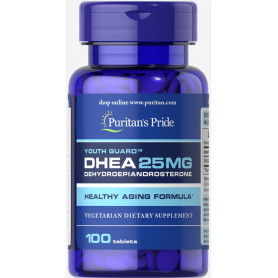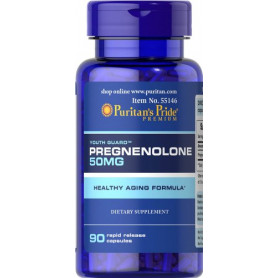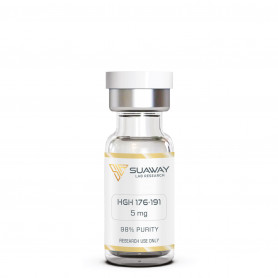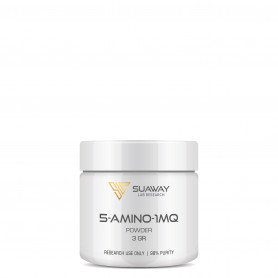IPAMORELIN - 5 mg
It has been shown that ipamorelin has effects on:
- Increased lean muscle mass
- Reduction in total body fat
- Sleep improvement
- Increased level of IGF-1
- Increased bone mineral content
- Enhanced capacity for the repair and regeneration of individual cells
- Increased in the synthesis of collagen
- Protection against the catabolic effects of glucocorticoids
Description
STRUCTURE
Sequence: H-Aib-His-D-2-Nal-D-Phe-Lys-NH2
Molecular Formula: C38H49N9O5
Molecular Weight: 711.868 g/mol
CAS: 170851-70-4
Peptide Purity: Greater than 98%.
Other details: No TFA Salt
Storage: Lyophilized peptide must be stored at -20°C and peptide solution at 4°C.
IPAMORELIN has low oral and excellent subcutaneous bioavailability.
DESCRITPION
Novo Nordisk is the company that discovered and produced ipamorelin, which is a pentapeptide hormone, an growth hormone secretagogue, and a specific molecular ghrelin mimetic. Ipamorelin, which is a member of the latest recent generation of GHRPs, is responsible for a considerable amount of growth hormone being released. In a manner that is similar to that of GHRP-6 and GHRP-2, it inhibits the activity of somatostatin while simultaneously enhancing the activation and secretion of testosterone (GH) from the anterior pituitary.
Ipamorelin has many of the same qualities as GHRP-2, including an absence of ghrelin's lipogenic capabilities and an absence of the hormone's ability to stimulate appetite. Ipamorelin has a synergistic effect when it is used in conjunction with Growth Hormone Release Hormone (GHRH) or an analog of GHRH, such as Sermorelin and Modified GRF 1-29.
The synergy comes both due to the suppression of somatostatin and the fact that ipamorelin increases GH release per-somatotrope, while GHRH increases the number of somatotropes releasing GH. On the other hand hand, Ipamorelin is comparable to GHRP-6 since both of these substances release GH at a level that is quite comparable, but Ipamorelin does not have the adverse effects that are associated with GHRP-6. Ipamorelin, on the other hand, only preferentially releases GH regardless of the dosage, in contrast to GHRP-6 and GHRP-2, which both produce a release and a rise in levels of cortisol and prolactin. Ipamorelin has a functioning that is comparable to that of hexarelin, and in comparison to another peptide, it is a more stable version of ghrelin. Additionally, its half-life is at least two hours longer than other peptides.
Ipamorelin has proven itself to be very effective as well as exceedingly selective in both in vivo and in vitro settings. Furthermore, it has shown that it is both safe and well tolerated in clinical trials involving humans. Ipamorelin only affects growth hormone levels, according to research, whereas pituitary hormones like cortisol continue to function normally when taking this medication. Ipamorelin administration over twelve weeks increased the bone mass of young adult female rats, according to the findings of one research. When compared to other Hormone Releasing Peptides, this particular peptide guarantees the advantages without exposing the user to the risk of experiencing any unfavorable side effects.
Six children with growth hormone deficiency and growth failure were administered with graded doses of 0.3 to 3 micrograms per kg per day for a period of eight months. Throughout this study, the children were monitored every 12 hours for episodic growth hormone secretion and toxicity levels. After two months of the graded dose treatment, it was noticed that the children showed a great spike in the growth hormone levels during the treatment and for a short period of time after the treatment, with little effect on the GH levels at the later stages. No toxicities and side effects were noticed.
Ipamorelin has been shown to boost growth hormone levels in mice by anywhere from three to thirteen times higher than their baseline levels, according to research conducted on mice. Studies conducted on animals under these circumstances indicate that a gain of about 9% in muscle and a drop of 14% in fat mass may be predicted without any modifications to either the amount of food consumed or the amount of activity performed.
The fall in GH levels is a normal process that occurs in conjunction with aging. Research indicates that GH levels just at age of 70 are around sixty percent lower than they were at the age of twenty. Because of this, exercise is less effective as we get older, which is also why we tend to lose muscle and bone mass in exchange for fat. When it comes to the make-up of an animal's body, the influence that ipamorelin has increased in proportion to the animal's age. According to studies conducted on rats, the highest levels of growth hormone (GH) production seem to provide the greatest advantages to the oldest animals.
As was said before, there are not many unwanted side effects associated with the use of ipamorelin. Ipamorelin, in contrast to other hormone drug that acts as receptor agonists, has a negligible to nonexistent impact on other hormones, such as thyroid hormone and cortisol. This is the reason for the phenomenon described above. This is significant since cortisol has been shown to hasten the breakdown of lean mass (including muscle and bone) while simultaneously encouraging the formation of fat tissue.
Studies conducted on animals have shown that ipamorelin may enhance the body's natural production of insulin.It does this by indirect stimulation of the calcium channel on pancreatic islet cells as well as through stimulation of the adrenergic receptor pathway. Increasing insulin levels by itself would be beneficial for stimulating the development of lean body mass; however, increasing insulin levels in conjunction with enhanced growth hormone release helps to explain how ipamorelin is so successful in generating fat loss and muscle gain in animal models.
It is well knowledge that ghrelin analogs, such as ipamorelin, have the potential to induce hunger and, as a consequence, increase food consumption. This is another piece of information that, when seen in the context of the paradigm of using ipamorelin for weight reduction, may seem to be paradoxical. However, this is not necessarily the case. To begin, among all of the ghrelin analogs, ipamorelin does have the lowest levels of hunger stimulation than any of the others. Ipamorelin is indeed a ghrelin mimic, and as such, it can inhibit the body's natural production of ghrelin. This is significant because, in theory, ipamorelin may be used to control the "hunger pangs" that ghrelin causes when a person has lost a significant amount of weight.
Ghrelin has been referred to be an adiposity signal on more than one occasion. It sends signals to the brain when the body's reserves of energy are starting to run low and motivates animals to look for food. Ghrelin has significant ties to the brain's cholinergic and dopaminergic reward systems as well.
The pleasure-inducing combination of the release of ghrelin and the binding of enkephalins. As a result, experiencing pleasure might be attributed to the relocation of ghrelin, which can be achieved by eating.
REFERENCES
N.B. Andersen et al., "The growth hormone secretagogue ipamorelin counteracts glucocorticoid-induced decrease in bone formation of adult rats" [PubMed]
A. Giustina et al., "Pathophysiology of the neuroregulation of growth hormone secretion in experimental animals and the human" [PubMed]
D.E. Beck et al., "Prospective, randomized, controlled, proof-of-concept study of the Ghrelin mimetic ipamorelin for the management of postoperative ileus in bowel resection patients [PubMed]
K. Raun et al., "Ipamorelin, the first selective growth hormone secretagogue" [PubMed]
J.V. Gobburu et al., "Pharmacokinetic-pharmacodynamic modeling of ipamorelin, a growth hormone releasing peptide, in human volunteers" [PubMed]
J. Svensson et al., "The GH secretagogues ipamorelin and GH-releasing peptide-6 increase bone mineral content in adult female rats" [PubMed]
R.G. Gondo et al., "Growth hormone-releasing peptide-2 stimulates GH secretion in GH-deficient patients with mutated GH-releasing hormone receptor" [PubMed]
M.M. Fowkes et al., "Peptidomimetic growth hormone secretagogue derivatives for positron emission tomography imaging of the ghrelin receptor" [PubMed]
B. Greenwood-Van Meerveld et al., "Efficacy of ipamorelin, a ghrelin mimetic, on gastric dysmotility in a rodent model of postoperative ileus" [PubMed]
E. Adeghate et al., "Mechanism of ipamorelin-evoked insulin release from the pancreas of normal and diabetic rats" [PubMed]
P.B. Johansen et al., "Ipamorelin, a new growth-hormone-releasing peptide, induces longitudinal bone growth in rats" [PubMed]
D.K. Sinha et al., "Beyond the androgen receptor: the role of growth hormone secretagogues in the modern management of body composition in hypogonadal males" [PubMed]
V. Mericq et al., "Effects of eight months treatment with graded doses of a growth hormone (GH)-releasing peptide in GH-deficient children" [PubMed]
DISCLAIMER
This product is intendend for lab research and development use only. These studies are performed outside of the body. This product is not medicines or drugs and has not been approved by the FDA or EMA to prevent, treat or cure any medical condition, ailment or disease. Bodily introduction of any kind into humans or animals is strictly forbidden by law. This product should only be handled by licensed, qualified professionals.
All product information provided on this website is for informational and educational purposes only.

